(完整版)七年级下册Unit3Ouranimalfriends教案-含课后作业
- 格式:doc
- 大小:65.38 KB
- 文档页数:14
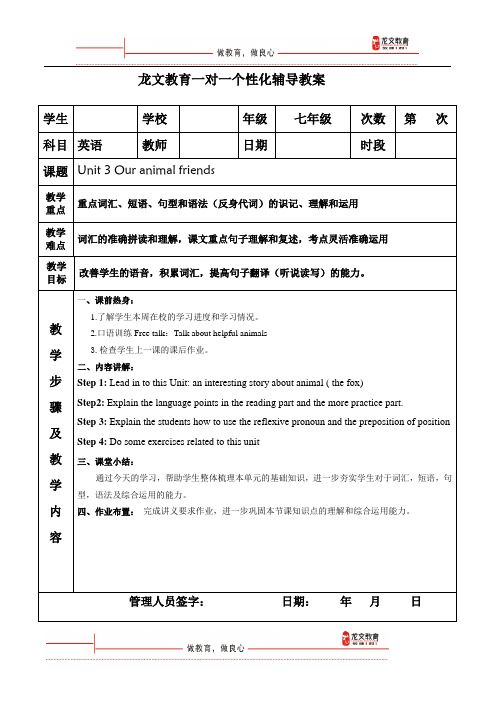
龙文教育一对一个性化辅导教案Unit 3 Our animal friendsA、Talk about helpful animalsTips:Cow elephant horse sheepI think….. are very helpful animals, they help us…..Without……. ,we can not……We get……from……….B、朗读Reading部分(一)、词汇1. blind adj.瞎的;失明的Read an article about a blind man and his guide dog.阅读篇关于一个盲人和他的导犬拓展:e.g. the blind人练一练:1) Yang Guang is an excellent _______ singer.2) She is _______ on the left eye.2. programme n.节目Listen to a radio programme about dogs.听一个关于狗的电台节目。
1)a music _________ 一个音乐节目2) This ________ is boring. Let’s change to another one.3. helpful adj. 有用的;有帮助的1)This English book is _______ to me.2) There is a _________ map on the shelf.4. mean v. 表示......的意思What do you think the word eyes means in the story?你认为故事中的“eyes”表示什么意思?拓展:meaning n. 意义,含义,意思;意图,目的mean to do 表示“打算做......”mean doing 表示“意味着......”e.g.1)American people use the word “apartment” to _______ flat.2)She _______ (mean) to attend Mina’s birthday party.3)What’s the behind of _______ (mean) this story?5. arrive at 到达1) 0ne day,John Dancer and Charlie arrived at a hotel.一天,约翰·当斯尔和查理到达一间旅店。
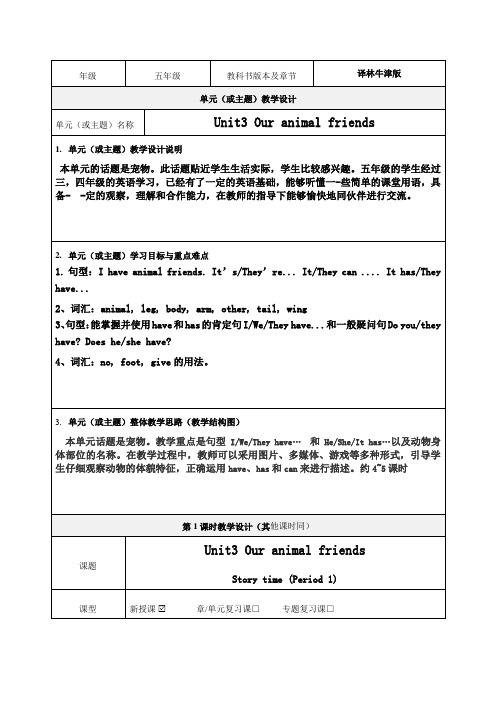
T:Our friends are talking about their animal friends, too. Who are they?Let’s watch and tick: What animal friends are they talking?2.Learn the first paragraph. (1) Read and tick.Q1.What do the fish have?Q2.What can the fish do?小提示:自读第一段,用查阅的方式,将选项弄明白后,在第1段中找答案。
图片也可以帮助你哦!(2) Let’s talk.They have________.They can________.3.Learn the second paragraph.(1) Listen and choose.T:We know Nancy’s animal friends are fish .How about Mike’s animal friend? Do you want to know? But wait a minute, let’s choosefirst .T: Let’s check, who can read it? T: Great! What is it?Can you say something about the dog? You can use:It has…It can...(2) Summary.T:Just now , you did it well. How to describe the animals?T:So ,we can describe the animals from colour, feature, ability and Ss read and tick.Ss talk.Ss talk.Ss think and talk.看图片,利用已有知识,运用句型尝试介绍。
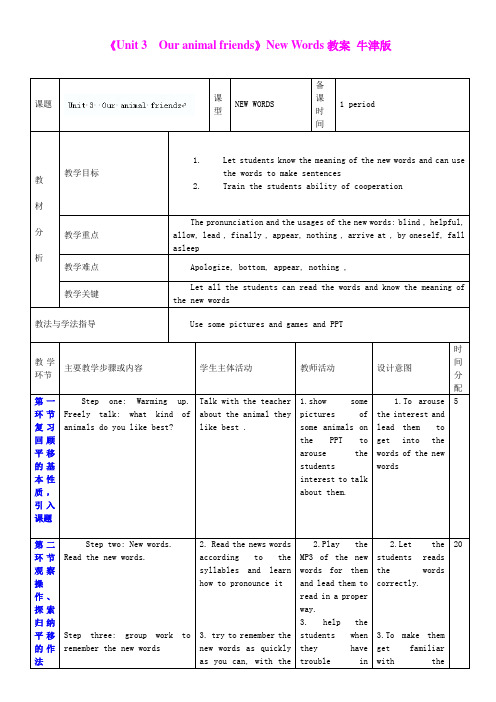

龙文教育一对一个性化辅导教案学生学校年级七年级次数第次科目英语教师日期时段课题Unit 3 Our animal friends教学重点重点词汇、短语、句型和语法(反身代词)的识记、理解和运用教学难点词汇的准确拼读和理解,课文重点句子理解和复述,考点灵活准确运用教学目标改善学生的语音,积累词汇,提高句子翻译(听说读写)的能力。
教学步骤及教学内容一、课前热身:1.了解学生本周在校的学习进度和学习情况。
2.口语训练Free talk:Talk about helpful animals3.检查学生上一课的课后作业。
二、内容讲解:Step 1: Lead in to this Unit: an interesting story about animal ( the fox)Step2: Explain the language points in the reading part and the more practice part.Step 3: Explain the students how to use the reflexive pronoun and the preposition of position Step 4: Do some exercises related to this unit三、课堂小结:通过今天的学习,帮助学生整体梳理本单元的基础知识,进一步夯实学生对于词汇,短语,句型,语法及综合运用的能力。
四、作业布置:完成讲义要求作业,进一步巩固本节课知识点的理解和综合运用能力。
管理人员签字:日期:年月日作业布置1、学生上次作业评价:○好○较好○一般○差备注:2、本次课后作业:课堂小结家长签字:日期:年月日Unit 3 Our animal friends一、口语训练A、Talk about helpful animalsTips:Cow elephant horse sheepI think….. are very helpful animals, they help us…..Without……. ,we can not……We get……from……….B、朗读Reading部分二、课程导入1. Which animal do you think is the strongest?2. Which animal do you think is the cleverest?3. Which animal do you think is the loyalist?4. Which animal do you think have the longest lifespan?5. Which animal do you think have four legs when it was newly born, two legs when it is young and three legs when it’s getting old?6. Here is a story about a dog and a fox, let’s see what happened.Bobby is my dog. I love him. He can roll on the floor. He can play balls with me. He can look after my house when I am out. Bobby is very clever. But sometimes he isn’t. One day Bobby runs away. He is out for three days.After he comes back, I tie him to a tree and give him some food. Bobby begins to eat. But then he stops. He sees a fox. The fox is looking at his food.Bobby barks and barks. He wants to catch the fox. But he can’t.The fox runs round the tree. Bobby runs after the fox. So the rope goes ground the tree. Of course Bobby can’t run.The fox can eat the food. Quickly she eats up the food and runs away。
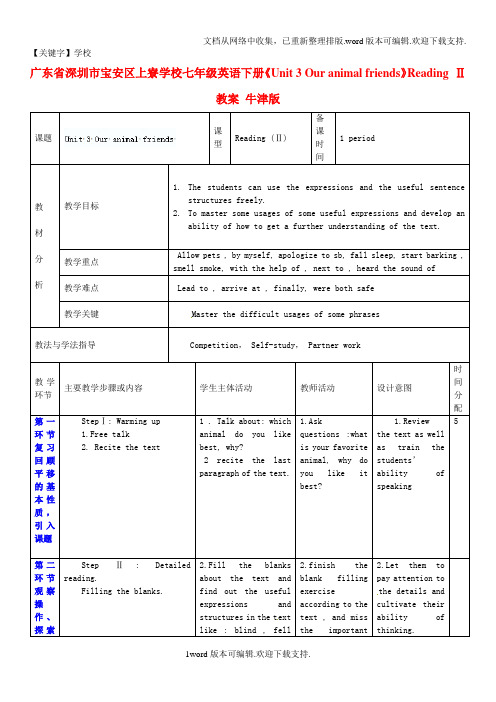
文档从网络中收集,已重新整理排版.word版本可编辑.欢迎下载支持. 【关键字】学校广东省深圳市宝安区上寮学校七年级英语下册《Unit 3 Our animal friends》Reading Ⅱ教案牛津版课题课型Reading (Ⅱ)备课时间1 period教材分析教学目标1.The students can use the expressions and the useful sentencestructures freely.2.To master some usages of some useful expressions and develop anability of how to get a further understanding of the text.教学重点Allow pets , by myself, apologize to sb, fall sleep, start barking ,smell smoke, with the help of , next to , heard the sound of教学难点 Lead to , arrive at , finally, were both safe教学关键Master the difficult usages of some phrases教法与学法指导Competition, Self-study, Partner work教学环节主要教学步骤或内容学生主体活动教师活动设计意图时间分配第一环节复习回顾平移的基本性质,引入课题StepⅠ: Warming up1.Free talk2. Recite the text1 . Talk about: whichanimal do you likebest, why?2 recite the lastparagraph of the text.1.Askquestions :whatis your favoriteanimal, why doyou like itbest?1.Reviewthe text as wellas train thestudents’ability ofspeaking5第二环节观察操作、探索Step Ⅱ: Detailedreading.Filling the blanks.2.Fill the blanksabout the text andfind out the usefulexpressions andstructures in the textlike : blind , fell2.finish theblank fillingexerciseaccording to thetext , and missthe important2.Let them topay attention tothe details andcultivate theirability ofthinking.归纳平移的作法StepⅢ:Important phrases and Sentence structureslearning. asleep , startedbarking ,smelt smoke,put the wet towelalong…, finally3. Make sentences withthese importantpoints in the text andtake notes of theexplanations of theimportant points:Arrive at ,/arrive in,allo w, by oneself ,lead to , fall sleep ,wake up, with sb’shelp, next to ,without sth, finally,phrases anddifficult pointin the blankfillingexercise3. Show somepictures by PPT,and explain theusage of theimportantphrases and themain languagepoints ,thebasicstructures ofthe text. Thenprepar e severalpaper whichcontain thesentence madewith theimpor tantphrases3.To develop thestudents’ability ofcooperation andto make everysure studenttake part in thework.第三环节课堂练习StepV I: More practice 4. Use the right formsof the expressions tofinish the sentences.5. Translate theChinese sentencesinto English by usingthe important phrasesin the text4.Give them anexample to dothe exercise.5. work in groupto check theanswers.4. to consolatethe usage of thekey points oft he text5. let studentsuse the usefulexpressionsthey learned第四环节课时小结Step Ⅵ: sum up 7.write down andremember theimportant points ofthis cl ass.6.Show a PPT andsum up the mainpoints of thetext and leadstudents to readit.第五环节课后作业Step V: Homework 1. remember theimportant points andprepare for thed ictation2. Make sentences withthe important pointsand structureslearned in this class课堂教学流程Free talk→ Reciting→ Get the important points and play games →Useful-structure→ Exercise效果评价与反思此文档是由网络收集并进行重新排版整理.word可编辑版本!。
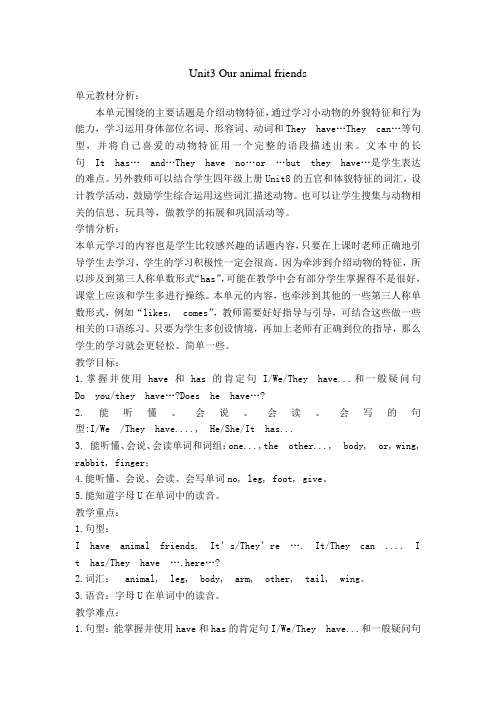
Unit3 Our animal friends单元教材分析:本单元围绕的主要话题是介绍动物特征,通过学习小动物的外貌特征和行为能力,学习运用身体部位名词、形容词、动词和They have…They can…等句型,并将自己喜爱的动物特征用一个完整的语段描述出来。
文本中的长句It has…and…They have no…or …but they have…是学生表达的难点。
另外教师可以结合学生四年级上册Unit8的五官和体貌特征的词汇,设计教学活动,鼓励学生综合运用这些词汇描述动物。
也可以让学生搜集与动物相关的信息、玩具等,做教学的拓展和巩固活动等。
学情分析:本单元学习的内容也是学生比较感兴趣的话题内容,只要在上课时老师正确地引导学生去学习,学生的学习积极性一定会很高。
因为牵涉到介绍动物的特征,所以涉及到第三人称单数形式“has”,可能在教学中会有部分学生掌握得不是很好,课堂上应该和学生多进行操练。
本单元的内容,也牵涉到其他的一些第三人称单数形式,例如“likes, comes”,教师需要好好指导与引导,可结合这些做一些相关的口语练习。
只要为学生多创设情境,再加上老师有正确到位的指导,那么学生的学习就会更轻松、简单一些。
教学目标:1.掌握并使用have和has的肯定句I/We/They have...和一般疑问句Do you/they have…?Does he have…?2.能听懂、会说、会读、会写的句型:I/We /They have...., He/She/It has...3. 能听懂、会说、会读单词和词组:one...,the other..., body, or, wing, rabbit, finger;4.能听懂、会说、会读、会写单词no, leg, foot, give。
5.能知道字母U在单词中的读音。
教学重点:1.句型:I have animal friends. It’s/They’re.... It/They can . (I)t has/They have ….here…?2.词汇:animal, leg, body, arm, other, tail, wing。
Unit 3 Our animal friends 教案课题:Unit 3 Our animal friends课型:Reading 课时:第 1 课时,共 4 课时教学目标1.Students can master how to pronounce the new words and master the meanings of the words .2.Let students know more about dogs.3.To master some usages of some useful expressions and develop an ability of howto get a further understanding of the text.4.Develop the reading ability and speaking skills教学重点: Know the structure and contents of the main article教学难点: Imagine the use of dogs. Find out more helpful animals in our daily life.教学准备: PPT, Blackboard教学步骤:Step I: Pre-reading1.Show a picture of a dog to arouse the interest and lead them to get into thetopic of this unit.a)Do you like dogs?b)Dogs are our friends.They help us a lot.2.Talk about the kinds of dogs in groups.3.Finish Exercise A on Page 30.A.Match the kinds of dogs in the box with the pictures below.4.Talk about the following questions and help the students answer them.a)What does a police dog do?b)What does a rescue dog do?c)What does a guide dog do?Step II: While-reading Procedure1.Look at the photos and the title of the story on page 31. Then answer the questions below. a)What do you think the word “ eyes ” means in the story?b)What is the story probably about?2.Read the text quickly and let the students get the general idea of the text.3.Read the first three paragraphs and answer the questions.a)Did the receptionist want to allow Charlie to stay in the hotel? Why or why not?b)What is Charlie?c)What did the receptionist do then?4.Read the last two paragraphs and complete the chart.5.Learn some new words and help them understand main words.Step III:Discussion1.Students work in groups and discuss the following question.How do dogs save people ?2.Encourage the students to given their possible answers.Step IV: Reading comprehension.Read the text in details and finish the blank filling exercise in a sheet, then check the answers. Step V: Sum upStep VI:Homework1.Read the text fluently2 write a passage to introduce your favorite animal.Step VII:The blackboard design课题:Unit 3 Our animal friends课型:Language points and grammars课时:第 2 课时,共 4 课时教学目标1. Students can understand and remember the main points.2. Students can master the grammars R eflexive pronouns a nd Preposition of position.3.Students can do some exercises about them.教学重点: Language Points教学难点:The grammars Reflexive pronouns a nd Preposition of position. 教学准备: PPT, Blackboard, music教学步骤:Step I: RevisionReview some main vocabulary.b.Retell the text in own words.c.Listen to the radio programme and finish A and B on Page 34.Step II: Group worka.Ask the students to collect the language points as much as possible in the text.b.Which group collect the most?Step III:. Language points learning.1.Explain main language points.2.Help the students make sentences with them to understand them better.3.Practice the language points to finish A and B on Page 34.4.Finish D1 on Page 33.Step IV: Grammars learning.Grammar A Reflexive pronouns1.Show PPT for them to understand what Reflexive pronoun s is.2.Encourage them to make sentences to help them understand.3.Find the sentences about R eflexive pronoun s in the text.4.Master the rule about Singular Reflexive pronoun a s n d Plura l Reflexive pronoun s.5.Finish the given exercises on Page 36.Grammar B Preposition of position.1.Show PPT for them to understand Preposition of position.2.Encourage them to make sentences to help them understand.3.Find the sentences about P reposition i.n the text.4.Finish the given exercises on Page 37.Step V: Practice the grammarsanize them to finish the exercise about the grammars in limited time .2. check the answers.Step VI: Sum upa.Know about Reflexive pronouns and Preposition..a.Show a PPT to guide the students to give sum up of the class.b..Help them to cultivate the ability of summarizing.Step VII.Homework:Make a dialogue in written way to talk about how a dog help people Step VIII. The blackboard designUnit3 Our animal friends课题: Unit 3 Our animal friends 课时: 第3课时共4课时课型: Reading 教学目标:1. Students can talk about dolphins.2. Students can get the main idea about T he Friendly Dolphin. 教学重点: Know more about friendly dolphins. 教学难点: Get the main idea about the story.教学准备: PPT, Blackboard教学方法: Group competition. 教学步骤:Step I:. Revision.a.Review the main language points.b.Review the grammars R eflexive pronouns a nd Preposition of position..Step II: Lead in.1.Show three pictures.Ask:a.What animals can you see in these pictures?b.Do you like them?c.What do you know about them? Can they save people' s lives?Step III:.Before reading1.Invite them to look at the pictures of sharks and dolphins.2.Answer the questions:What do you think of sharks and dolphins?Step IV:While readinga.Get the main idea of the story The Friendly Dolphin.b.Can talk about how a dolphin saved his life.c.Finish the given exercise on Page 40.d.Ask the students to note the tips.Step V: Group worka.In groups, role-play a press conference with the boy in the story.b.One student can be the boy saved by the dolphin, the other students can be journalists asking questions about the story.Step VI: Sum upStep VII:. Homework:Finish the exercises in this unit on your workbook.StepVIII: The blackboard designUnit3 Our animal friends课题: Unit 3 Our animal friends 课时: 第 4 课时,共 4 课时课型: Writing 教学目标:1.The students can talk about dogs laws.2.Students can write some sentences on helpful animals .3.Students should be ready to help others.. 教学重点: Talk about dogs laws. 教学难点: Write out the sentences about helpful animals..教学准备: PPT, Blackboard教学步骤:Step I: Before writing1.Read the culture corner about the dog laws in the UK.2.Answer the two questionsa.What must dogs wear in public places in the UK? Why?b.What kind of dogs needn' tt follow this law?c.Talk about the dog laws in our country.Step II:.Writing.a.Show a picture of animals on a farm.b.Choose one of the animals and talk about how it helps people.c.Write an article about it. Use the following words and the sentences to help you. Step III:Discussiona.Show a picture of animals.b.What animal do you like best?c.What is special about this animal?d.Why do you like this animal?e.Is this animal helpful to people?Step IV:Show time1.Walk around to find the better work to show around.2.Correct the work and recommend the better one to learn from. Step V: Sum up1.List the beautiful sentences they write in the passages2.Sum up some skills in writingStep VI: HomeworkRewrite the article in the exercise book.Step VII:. The blackboard designUnit 3 Our animal friends。
文档从互联网中收集,已重新修正排版,word格式支持编辑,如有帮助欢迎下载支持。
广东省深圳市宝安区上寮学校七年级英语下册《Unit 3 Our animal friends》NewWords教案牛津版课题课型NEW WORDS备课时间1 period教材分析教学目标1.Let students know the meaning of the new words and can usethe words to make sentences2.Train the students ability of cooperation教学重点The pronunciation and the usages of the new words: blind , helpful,allow, lead , finally , appear, nothing , arrive at , by oneself, fallasleep教学难点Apologize, bottom, appear, nothing ,教学关键Let all the students can read the words and know the meaning ofthe new words教法与学法指导Use some pictures and games and PPT教学环节主要教学步骤或内容学生主体活动教师活动设计意图时间分配第一环节复习回顾平移的基本性质,引入课题Step one: Warming up.Freely talk: what kind ofanimals do you like best?Talk with the teacherabout the animal theylike best .1.show somepictures ofsome animals onthe PPT toarouse thestudentsinterest to talkabout them.1.To arousethe interest andlead them toget into thewords of the newwords5第二环节观察操作、探索Step two: New words.Read the new words.2. Read the news wordsaccording to thesyllables and learnhow to pronounce it2.Play theMP3 of the newwords for themand lead them toread in a properway.2.Let thestudents readsthe wordscorrectly.20归纳平移的作法Step three: group work toremember the new wordsStep four: Key words learn ing.Step five: have a competition3. try to remember thenew words as quicklyas you can, with thehelp of the groupleader, then checkwith each otherwhether you rememberthe words or not .4. Work in groups tolearn the usage of thekey words, helpful ,anywhere, finally,nothing , arrive at,lead sb to , fallasleep , get down, byoneself, wake up5. match the new wordsand the pictures shownon the ppt3. help thestudents whenthey havetrouble inreading the n ewwords4.Show the PPTof the meaningof the key wordsand let ss makemore sentenceswith the newwords5. check thewords and givethem marks forthe groups3.To make themget familiarwith thepronunciationand the spellingof the newwords.4. Train thestu dents’ability tocooperate. Letthe students indifferent levescan take part inthe activity.5.Provie thechances tostudents to showthemselves andpractice thespeakingability.第三环节课堂练习Step six: exercise1. use the correct forms ofthe words to fill in theblanks like :My mother doesn’t allow me____( go) out at night.6. Finish the exercisegiven on the sheet.6.Collect themistakes in thestudents’exer cise.6. to consulatethe usages ofthe new w ords10第四环节课时小结step SevenHow many words do you master?Write them down in your sheet7. Remember the wordsyou learn and spellthem out7.Give them apiece of paperto write th ewords.7.To develop thestudents’ability of self–checking.5第五环节课后作业1.Dictatione the new words tomake sentences onyour own or check themin a dictionary4. Ask one student tolead all the studentsto read the new word.one student rea d onenew words.1.Dictation2.correct themistakesStrengthen theremembering ofthe words andsee if they canuse the wordscorrectly课堂教学流程Read the new words --- Games and remember the new words ---- learn the usages of the new words -----Exercise----check how they master the new words效果评价与反思。
广东省深圳市宝安区上寮学校七年级英语下册《Unit 3 Our animal friends》ReadingⅠ教案牛津版课题课型Reading备课时间1 period教材分析教学目标1. students can know how a guide dog help man and learn how to lovedogs2. Develop the reading ability and speaking skills教学重点Know how a guide dog help a man ,教学难点Know how to escape from a fire教学关键Try to make the text easier to learn教法与学法指导Reading competition, cooperation, self-study.教学环节主要教学步骤或内容学生主体活动教师活动设计意图时间分配第一环节复习回顾平移的基本性质,引入课题Step one: Free talk :Talk about what animal do youke ep at homestudents talk aboutthe animal they keepat home1. Show thequestions : doyou keep a dog orother animals athome?arouse theinterest andlead them toget into thetopic of thisun it.5第二 Step two: Fast reading 2. Read the text 2. Show the the 25环节观察操作、探索归纳平移的作法Step three: whi le-reading.Reading comprehension.Step four: Discussion quickly and answer thequestions3. Read the text indetails and finish theblank fillingexercise in a sh eet,then check theanswers ,after that ,try to designquestions accordingto the text and askyour classmates toanswer it .4. Talk in group : Ifther e is no the dogwith John , what wouldhappen that day?question:a. Can the doggo into thehotel at first?b. Why does theman take his dogeverywhere?c. How did theman wake up whenthere was smokein his room?d. who helpedJo hn put thetowel along thebottom of thedoor?e. who came tohelp John andthe dog out ofthe fire?3. hand out thesheet and designthe blankaccording to theimportantinformation.Then check theanswers withstud ents4. show a tablestudents get thegeneral idea ofthe text..make them getfamiliar withthe details ofthe text andtrain theirability ofreadingthe studentsspeakingability andcooperationability.about what happened that day?第三环节课堂练习Step five: exercise the exercise in PartC and Dthem to findthe details inthe text.5. To train thestudents’readingability .5第四环节课时小结step Six: Sum up 6 Sum up :How does adog help man?6. Show a PPT tosum up : thethings that adog can do forman.6. Prepare forthe writing5第五环节课后作业 Homework 1. Read the textfluently2 write a passage tointroduce what ca n adog do for manHand out asheet whichcontain therequest ofwriting thepassageStrengthen thecomprehensionof the text.课堂教学流程Free talk --- Preparation ---Reading competition ----- Discussion—exercise—sum up--Homework .效果评价与反思。
龙文教育一对一个性化辅导教案Unit 3 Our animal friendsA、Talk about helpful animalsTips:Cow elephant horse sheepI think….. are very helpful animals, they help us…..Without……. ,we can not……We get……from……….B、朗读Reading部分(一)、词汇1. blind adj.瞎的;失明的Read an article about a blind man and his guide dog.阅读篇关于一个盲人和他的导犬拓展:e.g. the blind人练一练:1) Yang Guang is an excellent _______ singer.2) She is _______ on the left eye.2. programme n.节目Listen to a radio programme about dogs.听一个关于狗的电台节目。
1)a music _________ 一个音乐节目2) This ________ is boring. Let’s change to another one.3. helpful adj. 有用的;有帮助的1)This English book is _______ to me.2) There is a _________ map on the shelf.4. mean v. 表示......的意思What do you think the word eyes means in the story?你认为故事中的“eyes”表示什么意思?拓展:meaning n. 意义,含义,意思;意图,目的mean to do 表示“打算做......”mean doing 表示“意味着......”e.g.1)American people use the word “apartment” to _______ flat.2)She _______ (mean) to attend Mina’s birthday party.3)What’s the behind of _______ (mean) this story?5. arrive at 到达1) 0ne day,John Dancer and Charlie arrived at a hotel.一天,约翰·当斯尔和查理到达一间旅店。
2) We _______ Guangzhou Baiyun Airport at 8 o’clock.3) They will _______ Furong Town on Monday.注意:arrive at后接较小的地方,如车站、旅店、小镇等;arrive in后接较大的地方,如国家、大城市等。
6. allow允许进入(或出去、通过)You're welcome to stay, but I'm sorry that we don’t allow pets here.我们欢迎您人住,但是很抱歉,宠物不得人内。
e.g.1) _______ me to ask a question.2) He doesn’t _______ anyone to take away his things.7. anywhere adv. 任何地方I am blind and I can’t go _______ by myself. 我是个盲人,任何地方都没法自己去.(二)、词组1. by oneself 独自She lives _______ in a flat in London.她独居在伦敦的一处公寓内。
2. apologize v. 道歉apologize to sb. for sth因某事向某人道歉The receptionist apologized and led John and Charlie to their room.接待员向他道歉,并将约翰和查理带到他们的房间。
I _______ for losing your bike.我为弄丢了你的自行车而向你道歉。
3.lead v. (过去式led)带领lead (sb.) to带着(某人)到……e.g .They wanted Alexande to _______ them.他们希望由亚历山大来领导。
He _______ the visitors to Mr Johnson”s room.他将来访者带到了约翰逊先生的房间。
4. fall asleep 入睡He soon fell asleep. 很快就睡着了.拓展: go to bed去睡觉sleep睡觉I could’t _______ last night. 昨晚我睡不着。
5. wake up 醒来wake v. (过去式woke)醒来e.g . 1) I _______ at 6:30 every morning. 我每天早晨六点半醒来。
2)Mum, ______ me ______ at seven tomorrow morning.妈妈,明天早晨七点叫醒我。
6. get down 蹲下;趴下Then he got down on the floor next to Charlie and waited. 然后他蹲在地板上,挨着查理,等待(救援)。
e.g . The little cat _______ on my desk and fell asleep. 小猫趴在我的书桌上睡着了。
get down 还有“下来”的意思。
7. finally adv. 终于;最后Finally, the fireman got Charlie out of the room too and they were both safe.最终,查理被消防员从房间内救出,他们俩都安全了。
1) We _______ arrived at Lijiang. 我们终于到达丽江。
2) “You are the winner,” she said _______ .“Well done!”“你是冠军。
”她最后说,“干得好!”课堂练习高频词:(中译英)高频短语:(中译英)1、friendly dolphin 一只友好的海豚Friendly 为形容词,意为“友好的”,其名词为friend, 反义词为unfriendly。
固定短语be friendly to sb 意为对某人友好Eg: Our teachers are very friendly to us.我们的老师对我们都很友好拓展:以-ly结尾的形容词还有lovely, lonely, lively, ugly, silly, daily, weekly,monthly,yearly….习题:你妈妈有着如此友善的微笑,Your mum has such a smile.2、Then I saw something moving towards me. 然后我看见有什么东西正在向我移动。
作正在进行I saw them playing basketball on the playground when I passed by.我经过时看到他们正在操场上打篮球拓展:See sb do sth. 看到某人做某事,动词see后跟带to的不定式做宾语补足语,强调动作的完整性。
练习:I often see him table tennis with his son on the olayground.我常看到他和他儿子在操场上打乒乓球I saw him table tennis with his son on the playgroud.我刚刚看见他和他儿子正在操场上打篮球3、It pushed me away from the shark. 它推着我远离鲨鱼Push 为动词,意为“推,挤”。
Push …. Away 意为“将。
推开”。
The policeman pushed the old lady away when he saw the bus coming towards her.当警察看到公共汽车向那位老妇人开来时,他一把将她推开了习题:一个男孩冲了过来,把我挤出了道A boy came rushing past and me out of the way.4、As soon as I stepped onto the beach, the dolphin swam away.就在我踏上海滩的时候,海豚游走了As soon as 意为“一…..就…….”,用于引导时间状语从句,主句为一般将来时,从句则使用一般现在时代替一般将来时。
She will give me a call as soon as she gets home.她一回家就会给我打电话习题:他一通过考试就会把这个好消息告诉我们(三).反身代词的用法1.作宾语,有些动词需有反身代词:absent, bathe, amuse, blame, dry, cut, enjoy, hurt, introduce, behaveWe enjoyed ourselves very much last night.我们昨晚玩得很开心。
Please help yourself to some fish.请你随便吃点鱼。
He thinks more of others than of himself.2.用于及物动词+宾语+介词: take pride in, be annoyed with, help oneself to sth.I could not dress (myself) up at that time.那个时候我不能打扮我自己。
3.作表语, 同位语be oneself: I am not myself today.我今天不舒服。
The thing itself is not important.事情本身并不重要。
4.反身代词有以下常见搭配enjoy oneself = have a good timeby oneself = alonehelp oneself to…5. 在不强调的情况下,but, except, for 等介词后宾语用反身代词或人称代词宾格均可。
如:No one but myself (me) is hurt.※注意:(1)oneself 有单复数之分I enjoy myself.Children, help yourselves to some fish.(2)有些动词后不跟反身代词,get up, sit-down, stand up, wake up等。